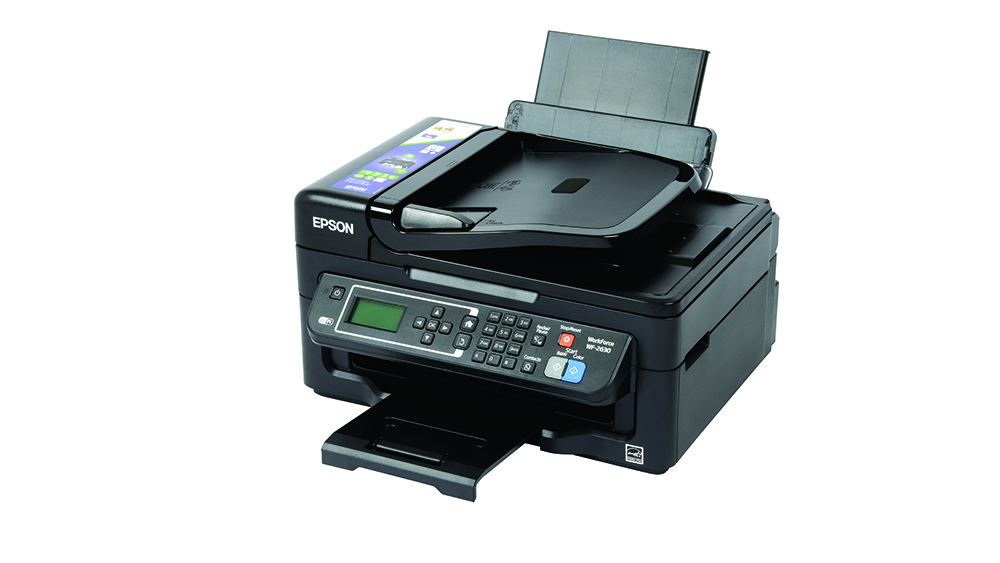Epson WorkForce WF-2630 review
For what you get, the price is certainly attractive, but performance is poor for both printing and scanning

A cheap entry price and well-rounded feature set are impressive, but high running costs and slow print speeds make the WF-2630 hard to recommend at any price.
-
+
Cheap cost of entry; Surprising amount of built-in features;
-
-
Expensive running costs; Painfully slow scanning speeds;

Epson's WF-2630 is substantially the same printer as the ET-4500, the difference being that it takes traditional ink cartridges rather than using the bottle-based EcoTank system. That makes it slightly more compact, as there are no ink reservoirs sticking out the side.
Aside from that, the rap sheets are identical. You get a 100-page paper tray and a 30-sheet ADF, but print speeds are every bit as mediocre as on the EcoTank model -- 7.6ppm for mono pages and 2.8ppm for colour. Ditto scanning: 22 seconds for a single greyscale page isn't too bad, and scan quality is very good -- but the ADF is painfully slow, taking more than five minutes to process our ten-page document.
Slightly to our surprise, a subtle variation in print quality was visible between the two printers. We couldn't spot any difference with text or colour graphics: text remained legible but choppy, while colour graphics were pleasingly warm and clean.
When it came to our high-quality photomontage, however, the WF-2630 edged ahead with a sharper, neater reproduction of fine photographic detail. Evidently the ink that comes in EcoTank bottles isn't precisely identical to the stuff that's sold in cartridges.
While the WF-2630 isn't exactly a looker, it's impressive that Epson has managed to build in an ADF, fax and both wired and wireless networking capabilities at this price. Predictably, that's offset by high running costs: Epson's "XL" supplies are rated for just 500 pages in mono and 450 in colour. At 50 for a four-colour pack, that translates to 2.5p per mono page and 10.7p for colour.
All the same, if you only ever print a low volume of pages, then the WF-2630 could be a cost-effective proposition. You're looking at 2,000 mono pages before the Brother MFC-J5620DW pulls ahead, and a further 6,000 before the Canon Maxify MB5350 starts to work out cheaper. Even after 20,000 pages, you'll still be quids in compared to most lasers. The problem is that, like the ET-4500, the WF-2630 is such a slow and undistinguished printer that it's hard to recommend at any price.
Get the ITPro daily newsletter
Sign up today and you will receive a free copy of our Future Focus 2025 report - the leading guidance on AI, cybersecurity and other IT challenges as per 700+ senior executives
Darien began his IT career in the 1990s as a systems engineer, later becoming an IT project manager. His formative experiences included upgrading a major multinational from token-ring networking to Ethernet, and migrating a travelling sales force from Windows 3.1 to Windows 95.
He subsequently spent some years acting as a one-man IT department for a small publishing company, before moving into journalism himself. He is now a regular contributor to IT Pro, specialising in networking and security, and serves as associate editor of PC Pro magazine with particular responsibility for business reviews and features.
You can email Darien at darien@pcpro.co.uk, or follow him on Twitter at @dariengs.
-
 Global cybersecurity spending is set to rise 12% in 2025 – here are the industries ramping up investment
Global cybersecurity spending is set to rise 12% in 2025 – here are the industries ramping up investmentNews Global cybersecurity spending is expected to surge this year, fueled by escalating state-sponsored threats and the rise of generative AI, according to new analysis from IDC.
By Ross Kelly Published
-
 ‘Phishing kits are a force multiplier': Cheap cyber crime kits can be bought on the dark web for less than $25 – and experts warn it’s lowering the barrier of entry for amateur hackers
‘Phishing kits are a force multiplier': Cheap cyber crime kits can be bought on the dark web for less than $25 – and experts warn it’s lowering the barrier of entry for amateur hackersNews Research from NordVPN shows phishing kits are now widely available on the dark web and via messaging apps like Telegram, and are often selling for less than $25.
By Emma Woollacott Published
-
 Redis unveils new tools for developers working on AI applications
Redis unveils new tools for developers working on AI applicationsNews Redis has announced new tools aimed at making it easier for AI developers to build applications and optimize large language model (LLM) outputs.
By Ross Kelly Published